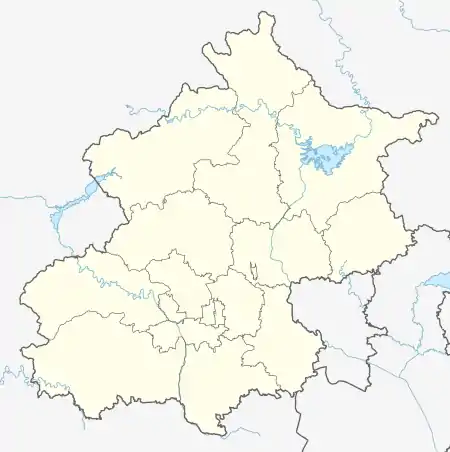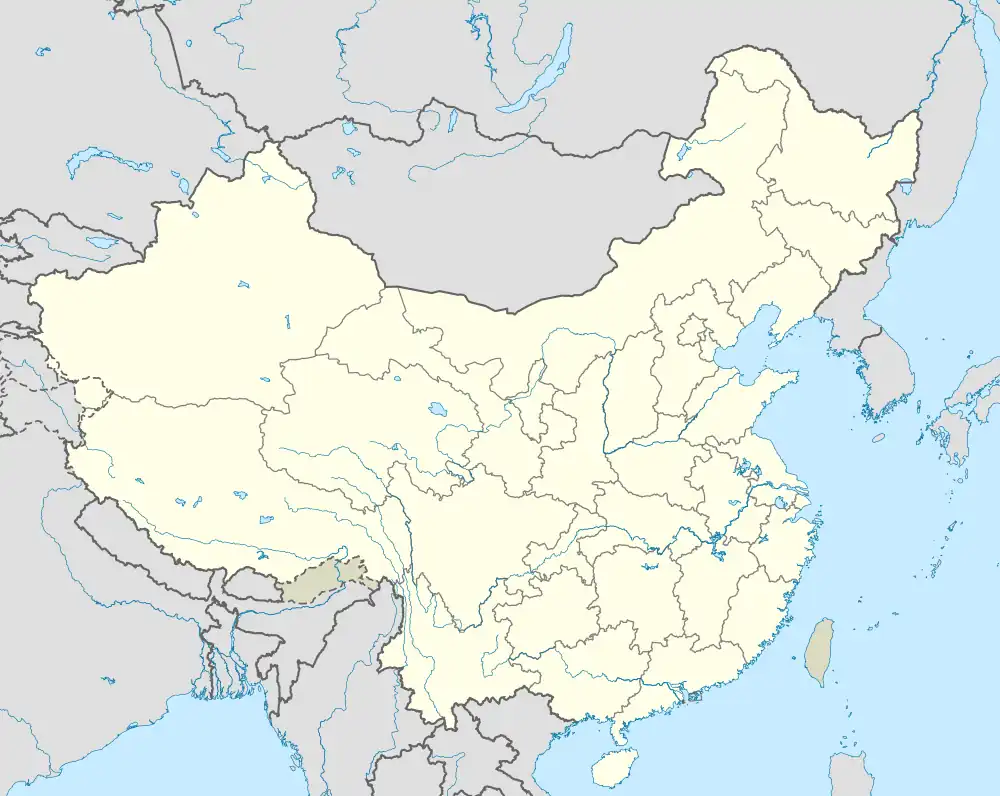Guanyinsi Subdistrict
观音寺街道 | |
|---|---|
.jpg.webp) Headquarters of Yili Bread and Arctic Ocean Company, 2020 | |
.png.webp) Location within Daxing District | |
 Guanyinsi Subdistrict  Guanyinsi Subdistrict | |
| Coordinates: 39°44′32″N 116°20′46″E / 39.74222°N 116.34611°E | |
| Country | China |
| Municipality | Beijing |
| District | Daxing |
| Village-level Divisions | 21 communities |
| Area | |
| • Total | 14.32 km2 (5.53 sq mi) |
| Elevation | 43 m (141 ft) |
| Population (2020) | |
| • Total | 111,225 |
| • Density | 7,800/km2 (20,000/sq mi) |
| Time zone | UTC+8 (China Standard) |
| Postal code | 102617 |
| Area code | 010 |
Guanyinsi Subdistrict (simplified Chinese: 观音寺街道; traditional Chinese: 觀音寺街道; pinyin: Guānyīnsì Jiēdào) is a subdistrict in the northern portion of Daxing District, Beijing, China. It is located at the south and west of Xihongmen Town, north of Tiangongyuan Subdistrict and Huangcun Town, northeast of Xingfeng and Linxiao Road Subdistricts, and east of Qingyuan and Gaomidian Subdistricts. In the year 2020, it had a total population of 111,225.[1]
The name of this subdistrict is referring to a temple dedicated to Guanyin within its borders.[2]
History
| Year | Status | Within |
|---|---|---|
| 1912 - 1928 | Daxing County, Capital Area | |
| 1928 - 1937 | 3rd Prefecture, Hebei | |
| 1937 - 1949 | 5th Prefecture, Hebei | |
| 1949 - 1958 | Tong County, Hebei | |
| 1958 - 1981 | Daxing County, Beijing | |
| 1981 - 2001 | Part of Huangcun Town | |
| 2001 - 2009 | Part of Qingyuan Subdistrict and Xingfeng Subdistrict | Daxing District |
| 2009 - present | Guanyinsi Subdistrict |
Administrative divisions
In 2021, Guanyinsi Subdistrict comprised 21 communities:[3]
| Administrative Division Code | Subdisvision Names | Name Transliteration |
|---|---|---|
| 110115009001 | 双河北里 | Shuanghe Beili |
| 110115009002 | 新安里 | Xin'anli |
| 110115009003 | 团河 | Tuanhe |
| 110115009004 | 南湖园 | Nanhuyuan |
| 110115009005 | 观音寺南里 | Guanyinsi Nanli |
| 110115009006 | 观音寺 | Guanyinsi |
| 110115009007 | 双河南里 | Shuanghe Nanli |
| 110115009008 | 新居里 | Xinjuli |
| 110115009009 | 盛春坊 | Shengchunfang |
| 110115009010 | 金华里 | Jinhuali |
| 110115009011 | 开发区 | Kaifaqu |
| 110115009012 | 泰中花园 | Taizhong Huayuan |
| 110115009013 | 观音寺北里 | Guanyinsi Beili |
| 110115009014 | 首座御园一里 | Shouzuo Yuyuan Yili |
| 110115009015 | 盛嘉华苑 | Shengjia Huayuan |
| 110115009016 | 首座御园二里 | Shouzuo Yuyuan Erli |
| 110115009017 | 首座御园三里 | Shouzuo Yuyuan Sanli |
| 110115009018 | 首座御园四里 | Shouzuo Yuyuan Sili |
| 110115009019 | 双河北里尚城 | Shuanghe Beili Shangcheng |
| 110115009020 | 美澜湾西区 | Meilanwan Xiqu |
| 110115009021 | 美澜湾东区 | Meilanwan Dongqu |
See also
References
- ↑ "北京市大兴区第七次全国人口普查公报". www.bjdx.gov.cn (in Chinese). Retrieved 2022-10-22.
- 1 2 Zhong hua ren min gong he guo zheng qu da dian. Bei jing shi juan. Li li guo, Li wan jun, Wu shi min, 李立国., 李万钧., 吴世民. Bei jing: Zhong guo she hui chu ban she. 2013. ISBN 978-7-5087-4058-4. OCLC 910451741.
{{cite book}}: CS1 maint: others (link) - ↑ "2021年统计用区划代码和城乡划分代码". www.stats.gov.cn. Retrieved 2022-10-21.
This article is issued from Wikipedia. The text is licensed under Creative Commons - Attribution - Sharealike. Additional terms may apply for the media files.